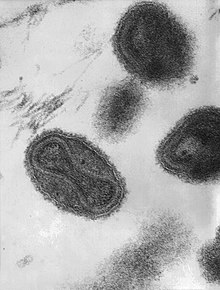Small Pox
| Smallpox | |
|---|---|
 |
|
| A child infected with smallpox in Bangladesh, 1973. Patients with ordinary-type smallpox usually had bumps filled with a thick and opaque fluid, often with a depression or dimple in the center. This is a major distinguishing characteristic of the disease. | |
| Classification and external resources | |
| Specialty | Infectious disease |
| ICD-10 | B03 |
| ICD-9-CM | 050 |
| DiseasesDB | 12219 |
| MedlinePlus | 001356 |
| eMedicine | emerg/885 |
| Patient UK | Smallpox |
| MeSH | D012899 |
| Variola virus (Smallpox) | |
|---|---|
 |
|
| This transmission electron micrograph depicts a number of smallpox virions. The "dumbbell-shaped" structure inside the virion is the viral core, which contains the viral DNA; Mag. = ~370,000x | |
| Virus classification | |
| Group: | Group I (dsDNA) |
| Order: | Unassigned |
| Family: | Poxviridae |
| Subfamily: | Chordopoxvirinae |
| Genus: | Orthopoxvirus |
| Type species | |
|
Vaccinia virus |
|
| Species | |
|
Variola virus |
|
Smallpox was an infectious disease caused by either of two virus variants, Variola major and Variola minor. The disease is also known by the Latin names variola or variola vera, derived from varius ("spotted") or varus ("pimple"). The disease was originally known in English as the "pox" or "red plague"; the term "smallpox" was first used in Britain in the 15th century to distinguish variola from the "great pox" (syphilis). The last naturally occurring case of smallpox (Variola minor) was diagnosed on 26 October 1977.
Infection with smallpox is focused in small blood vessels of the skin and in the mouth and throat before disseminating. In the skin it results in a characteristic maculopapular rash and, later, raised fluid-filled blisters. V. major produced a more serious disease and had an overall mortality rate of 30–35 percent. V. minor caused a milder form of disease (also known as alastrim) which killed about 1 percent of those it infects. Long-term complications of V. major infection included characteristic scars, commonly on the face, which occur in 65–85 percent of survivors.Blindness resulting from corneal ulceration and scarring, and limb deformities due to arthritis and osteomyelitis were less common complications, seen in about 2–5 percent of cases.
Smallpox is believed to have been acquired by humans originally as a zoonosis from a terrestrial African rodent between 16,000 and 68,000 years ago, well before the dawn of agriculture and civilization. The earliest physical evidence of it is probably the pustular rash on the mummified body of Pharaoh Ramses V of Egypt. The disease killed an estimated 400,000 Europeans annually during the closing years of the 18th century (including five reigning monarchs), and was responsible for a third of all blindness. Of all those infected, 20–60 percent—and over 80 percent of infected children—died from the disease. Smallpox was responsible for an estimated 300–500 million deaths during the 20th century. As recently as 1967, the World Health Organization (WHO) estimated that 15 million people contracted the disease and that two million died in that year.
...
Wikipedia
